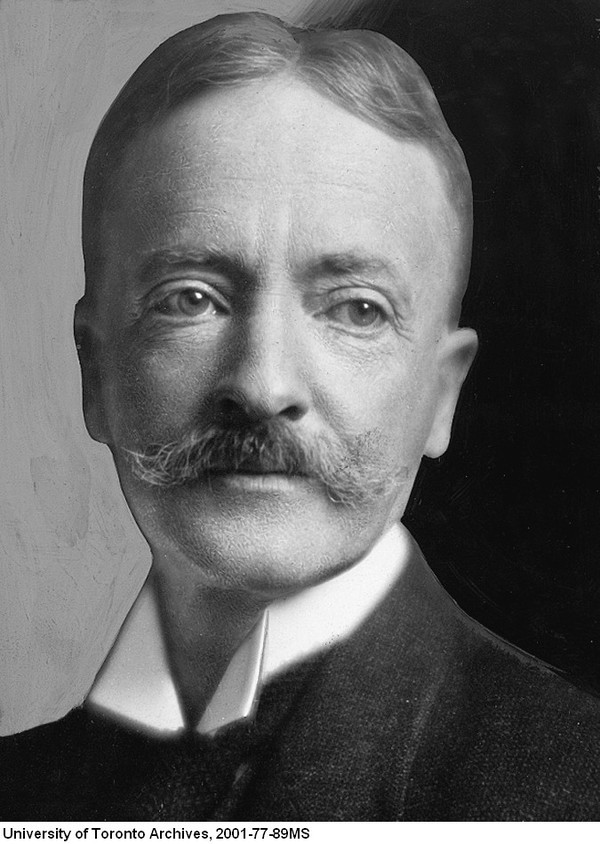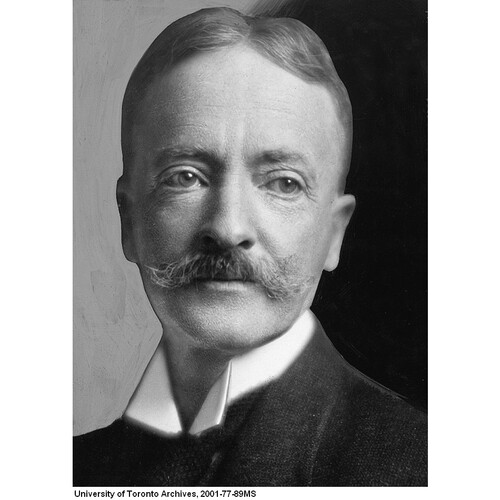
Source: Link
MILLER, WILLIAM LASH, chemist, university professor and administrator, and author; b. 10 Sept. 1866 in Galt (Cambridge), Upper Canada, son of William Nicholas Miller and Frederica Louisa Lash; nephew of Zebulon Aiton Lash*; m. 11 July 1895 Pauline Catherine Van Santen (d. 26 Sept. 1949) in Amsterdam, and they had one son and two daughters; d. 1 Sept. 1940 in Toronto.
Lash Miller – he signed W. Lash, and does not seem to have used his first name – was the son of a lawyer who practised in Galt, Brampton, and finally Toronto. As an undergraduate at the University of Toronto, he attended lectures given by the department of chemistry and worked in its laboratory; he earned his ba in natural science in 1887, graduating at the top of his class and receiving a gold medal. He spent the next three years in Germany, where he studied chemistry in Berlin, Göttingen, and Munich, and was awarded a phd by the University of Munich in 1890. That summer he was a student of the German chemist Friedrich Wilhelm Ostwald at the University of Leipzig. On his return to Toronto, Miller became a fellow in chemistry for one year, and then a demonstrator. In the summer of 1892 he went back to work with Ostwald, and later that year he received, from Leipzig, a second doctorate. The time Miller spent in Ostwald’s laboratory “was a turning point” in his life, according to chemist Donald J. Leroy. There “he first became acquainted with the elegance and applicability to chemistry of the thermodynamic approach of [the American scientist] Josiah Willard Gibbs.” In 1894 Miller was appointed a lecturer in chemistry at the University of Toronto. The following July he travelled to Amsterdam to marry Pauline Catherine Van Santen, daughter of Jan Joseph Van Santen, general manager of the Netherlands India Commercial Bank.
By 1898 Miller was recognized as a brilliant chemist, and that year he was named interim head of the department after the current head, William Herbert Pike, indicated that he would soon retire. Miller expected to succeed Pike, but in 1900 Premier George William Ross*’s provincial government, which made all the university’s teaching appointments [see Sir Daniel Wilson*], instead brought in William Robert Lang of the University of Glasgow. Although Miller considered leaving the university, he decided to remain after he was appointed associate professor of physical chemistry that year. Lang and Miller had tense relations, particularly after Miller took a dispute over laboratory space to university president James Loudon* and Minister of Education Richard Harcourt. Miller became a full professor in 1908 and managed the department during World War I, when Lang was serving with the army. In 1920 Lang left the chemistry department to teach military studies at the university, and the following year Miller finally replaced him as head, the position he would hold until his retirement in 1937.
Miller terrified his students when lecturing on physical chemistry. Although, as his friend and colleague Frank Boteler Kenrick would recall, he often “lounged on the edge of the table, smoking and talking cheerfully to his class,” he insisted on clarity of thought, asked his pupils probing questions, and sent them to the blackboard to work out answers. Those who could not meet his demand for logic were shown no mercy, but many would praise him in retrospect for having taught them how to think. He attracted outstanding graduate students, including Kenrick and Andrew Robertson Gordon, both of whom would become heads of the chemistry department, and Clara Cynthia Benson*, who in 1903 was one of the first two women to receive a phd from the university. During his later years Miller would boast that over 20 of his students had become professors of physical chemistry at universities in the United States and the British empire.
According to LeRoy, “Miller had a record of outstanding research in several areas of physical chemistry: chemical equilibriums, rates of reaction, electrochemistry, transference numbers, over-voltage, high-current electric arcs, and diffusion.” He played a major role in interpreting the work of Gibbs on chemical thermodynamics. In 1892 Miller’s first physicochemical research on the electromotive force of metal electrodes confirmed a prediction he had made based on one of Gibbs’s equations. One of his most important contributions was his 1897 paper “On the second differential coefficients of Gibbs’ function ζ …,” in which he proved that an observation (by one of his students) opposite to that predicted by then-current theories was a logical consequence of thermodynamic reasoning. Throughout his career, Miller would teach using Gibbs’s monograph on thermodynamics, translating its author’s very theoretical treatment into laboratory terms.
Miller strove for perfection in his publications, going over them repeatedly to ensure the accuracy and clarity of every sentence. During his career he would author or co-author nearly 150 research papers. Leroy Egerton Westman, editor of Canadian Chemistry and Process Industries, would point out in a 1940 obituary that Miller “made it a practice early to allow quite junior workers to receive all honour for their papers by having their names appear first, or alone, being satisfied for himself with a casual mention in the last paragraph.”
In the early 1900s Miller helped form a sub-department of electrochemistry, and his research in that field would lead to many publications, including a major paper co-written in 1910 with Thomas Reeve Rosebrugh, a professor of electrical engineering (and son of inventor Abner Mulholland Rosebrugh*). Miller realized how chemistry could be applied in industry, and his practical research produced many papers. He took students to industrial meetings, taught electroplaters and those who dealt with electric furnaces, and learned in turn from their workplace experiences. “The industrial accomplishments of this professor,” Westman noted, “have extended directly and indirectly to some of the largest industries in America.”
In 1903 Miller, his colleagues, and his students began long-lasting, intensive research into the observation that the growth of yeast required, in addition to salt and sugar, the substances in wort that had been named “bios” by Eugene Wildiers, a Belgian chemist. Miller’s never-give-up approach was probably responsible for his huge expenditure of time and resources in the pursuit of this research, which resulted in at least 56 publications but never enabled him and his group to identify all the constituents of bios. Chemists Adrian Gibbs Brook and William Arthur Evelyn McBryde note that, in retrospect, “the endeavour seems a misdirection of Miller’s talents,” because bios was “a not very significant topic,” as well as “one perhaps beyond his experimental means,” due to the limitations of the techniques used at the time for separation and identification.
Miller’s greatest weakness was that he did not use or teach the atomic and molecular theories that were central to 20th-century chemistry. His refusal to accept these theories caused his department to be isolated from the mainstream of the field, and his textbook for Ontario schools, The new requirements in chemistry for junior matriculation (Toronto, 1905) had an unfortunate effect on teaching that would last for decades.
Miller was active in the many scientific societies to which he belonged. He was elected a fellow of the Royal Society of Canada in 1899, served as its president in 1934–35, and received the Flavelle Medal, endowed by businessman Sir Joseph Wesley Flavelle and awarded for achievements in biological science, in 1938. An associate editor of the Journal of Physical Chemistry and the Journal of the American Chemical Society (holding the latter position from 1913 to 1924), he was made an honorary member of the ACS in 1926. He also held the presidencies of the American Electrochemical Society (1912–13) and the Chemical Institute of Canada (1926). In 1923 Miller was judged by Yale University to be one of the seven most eminent physical chemists in the world, and he was invited to give an address at the opening of its new Sterling Chemical Laboratory. He was made a cbe in 1935.
Lash Miller was a brilliant scholar, researcher, and mathematician with intense powers of concentration and a remarkable memory. As a teacher, he demanded logical thinking, accuracy, and painstaking care. In disputes he was sometimes aggressive, but in his personal relationships he could be sympathetic and witty. Frank Kenrick recalled: “He ran rifle associations, blasted rocks, built boathouses, organized societies, grew irises, and collected books with the same energy, with the same logic and clear thinking, and with the same kindness and generosity that he showed in the laboratory, and the fact that he never threw anything away, never tidied up his room, and never knew who anybody was only endeared him all the more to his friends.” Wilder Dwight Bancroft, an American chemist and lifelong friend, observed simply, “Physical chemistry in Canada owes more to Miller than to any other one man.” The University of Toronto’s chemistry building, the Lash Miller Chemical Laboratories, is named after him.
In addition to the textbook noted in the biography, William Lash Miller is the author of or contributor to approximately 150 publications, many of which show only his student as the author, with thanks given to Miller in the last paragraph. Some of his most important works are “On the second differential coefficients of Gibbs’ function ζ: the vapour tensions, freezing and boiling points of ternary mixtures,” Journal of Physical Chemistry (Ithaca, N.Y.), 1 (1896–97): 633–42; “Wildiers’ bios,” Science (Lancaster, Pa), 59 (January–June 1924): 197–99; and “The method of Willard Gibbs in chemical thermodynamics,” Chemical Reviews (Champaign, Ill.), 1 (April 1924–January 1925): 293–344. In collaboration with F. B. Kenrick he published “Note on the identification of basic salts,” Journal of Physical Chemistry, 7 (1903): 259–68; and with T. R. Rosebrugh, Miller also wrote “Numerical values of certain functions involving e-x,” RSC, Trans., 2nd ser., 9 (1903), sect.iii: 73–107; and “Mathematical theory of the changes of concentration at the electrode, brought about by diffusion and by chemical reaction,” Journal of Physical Chemistry, 14 (1910): 816–84. Along with A. R. Gordon, Miller wrote “Numerical evaluation of infinite series and integrals which arise in certain problems of linear heat flow, electrochemical diffusion, etc.,” Journal of Physical Chemistry, 35 (1931): 2785–884.
UTARMS, B1976-0007 (Miller family records); P78-0313 (Papers from the chemical laboratories). W. D. Bancroft, “William Lash Miller, 1866–1940,” American Chemical Soc., Journal (Washington), 63 (1941): 1–2. A. G. Brook and W. A. E. McBryde, Historical distillates: chemistry at the University of Toronto since 1843 (Toronto, 2007). Canadian men and women of the time (Morgan; 1912). A history of chemistry in Canada, comp. C. J. S. Warrington and R. V. V. Nicholls (Toronto, 1949). F. B. Kenrick, “William Lash Miller (1866–1940),” RSC, Trans., 3rd ser., 35 (1941): 131–35; “William Lash Miller, 1866–1940,” Chemical Soc., Journal (London) (1942): 334–36. D. J. Le Roy, “Complete dictionary of scientific biography,” Miller, William Lash: www.encyclopedia.com/science/dictionaries-thesauruses-pictures-and-press-releases/miller-william-lash (consulted 26 April 2017). W. A. E. McBryde, “William Lash Miller (1866–1940),” in Electrochemistry, past and present, ed. J. T. Stock and M. V. Orna (Washington, 1989), 165–70. L. E. Westman, “William Lash Miller: a brief series of comments on the man and his mind, the teacher and his times,” Canadian Chemistry and Process Industries (Toronto), 24 (1940): 476–78.
Cite This Article
Marian A. Packham, “MILLER, WILLIAM LASH,” in Dictionary of Canadian Biography, vol. 16, University of Toronto/Université Laval, 2003–, accessed December 22, 2025, https://www.biographi.ca/en/bio/miller_william_lash_16E.html.
The citation above shows the format for footnotes and endnotes according to the Chicago manual of style (16th edition). Information to be used in other citation formats:
| Permalink: | https://www.biographi.ca/en/bio/miller_william_lash_16E.html |
| Author of Article: | Marian A. Packham |
| Title of Article: | MILLER, WILLIAM LASH |
| Publication Name: | Dictionary of Canadian Biography, vol. 16 |
| Publisher: | University of Toronto/Université Laval |
| Year of publication: | 2021 |
| Year of revision: | 2021 |
| Access Date: | December 22, 2025 |



